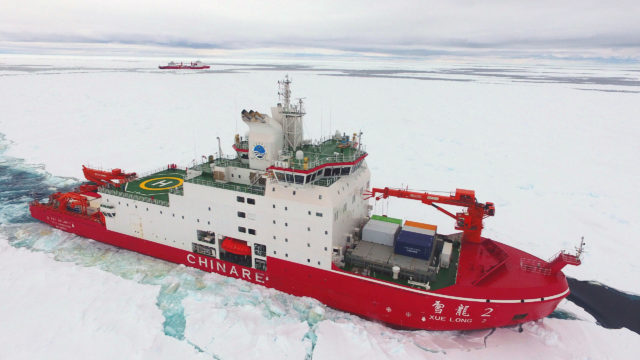
Second Chinese Icebreaker Heads to Northern Sea Route, Shifting Power Balance in Arctic
Publication: Eurasia Daily Monitor Volume: 17 Issue: 108
By:

In mid-July, China dispatched its Snow Dragon-2 icebreaker to the Northern Sea Route (NSR). This action marks yet another step toward realizing Beijing’s longstanding plans to displace Moscow as the dominant power in the Arctic as well as to establish Chinese preeminence on that east-west maritime corridor, which hugs Russia’s northern coast (see EDM, June 12, 2019 and September 3, 2019). The icebreaker’s voyage has exacerbated Russian concerns about China’s role in the northern polar region. But it has additionally rung alarm bells in Washington and other Western capitals, which do not want to see the Arctic pass from being a Russian fief to a Chinese one. This development, thus, raises the stakes at the next Arctic Council meeting, now delayed until next year.
Russia lacks the infrastructure or capital necessary for the NSR’s development; and at the same time, Moscow views a more robust Chinese presence in the Arctic as the lesser evil to an expanded presence by the United States. Consequently, the Kremlin had not reacted negatively in the past to Beijing’s assertiveness (see EDM, December 6, 2018). In contrast, Washington has all along been more opposed to China’s growing Arctic footprint. And as such, it is likely to view the latest Chinese move as something requiring a response—even though, at present, the US lacks an icebreaker fleet to challenge what Beijing is doing. Analysts in Moscow and Washington could be dismissive of the Snow Dragon’s appearance were it not for one thing: given global warming, a single icebreaker on the NSR now represents a much greater power position than would have been the case only four or five years ago.
As it has done in the past, Beijing is playing down the geopolitical consequences of its icebreaker tour, suggesting that the Snow Dragon-2’s visit to the Arctic—just like its recently completed voyage to the Antarctic—is strictly concerned with scientific research (News.cn, July 16; The Barents Observer, July 21). But Russian reports are not taking China’s claims at face value, especially since the ship will traverse much of the Northern Sea Route rather than simply go into the Arctic and then return to Shanghai. The vessel’s route will take it more than 12,000 kilometers, ending only in September, longer than China’s ten previous “scientific research” visits to the Arctic Ocean (Arctic.ru, Rus-shipping.ru, July 17; Regnum, July 16).
Russia is concerned about this latest voyage for two main reasons. First, this is now the second Chinese icebreaker to enter the Arctic. All earlier visits were made by the Snow Dragon-1. Consequently, the arrival of a new ship, even under the flag of a scientific research mission, proves that Beijing possesses at least two long-range icebreakers it can deploy in the region—more than the US, albeit still far fewer than Moscow wields. At the same time, however, many of Russia’s icebreakers either are out of commission or are not intended for more than restricted harbor clearing operations (Windowoneurasia2.blogspot.com, December 16, 2019).
The second reason for Russia’s anxiety stems from the fact that the evolving consequences of global climate change have today clearly become part of geopolitical competition. If China could not hope to challenge Russia along the NSR when shipping there required accompanying icebreakers most of the year over most of the route, the task has become much easier now that ever more of this Arctic maritime corridor is ice free for longer periods. Fewer ships are required, thus facilitating regional shifts in the balance of power. Chinese officials have alluded to this and said, last year, that Beijing stands ready to make a contribution to the opening of the Arctic because it views itself as “a near-Artic state” (The Barents Observer, May 14, 2019).
At that time, Wang Hong, the head of China’s State Oceanic Administration within the country’s Ministry of Natural Resources, stressed that China “respects the sovereignty of Arctic nations” but wants to expand its presence and cooperation with them on what Beijing’s leaders call the “Polar Silk Road” (The Barents Observer, May 14, 2019). The term underscores how important this route—one of six “one belt, one road” links between China and Europe that President Xi Jinping has been promoting—is to Beijing’s overall global geo-economic strategy.
Despite Russia’s presumed discomfort with China’s expanding role in the Arctic, its reaction will probably remain restrained. The first noticeable flashpoint may occur at an upcoming summit of the Arctic Council, of which Russia and the US are members but China is not. Beijing (currently an Observer) wants to join, even though it does not have any coastline on the northern ocean. However, China’s new icebreaker presence could give it more credibility as “an Arctic power” that should have a seat at that table. Moscow may feel it has no choice but to go along given that unless China continues to expand its operations in the Arctic, Russia will be even more marginalized vis-à-vis the Western Arctic powers. The United States and the other Council members, on the other hand, are likely to oppose any change. But as the diplomats say, China with its icebreakers is creating “facts on the ground” that others may be hard pressed to deny. The next Arctic Council meeting has been delayed by the pandemic. But when it does occur, in 2021, China may have a better case for membership than ever before.



